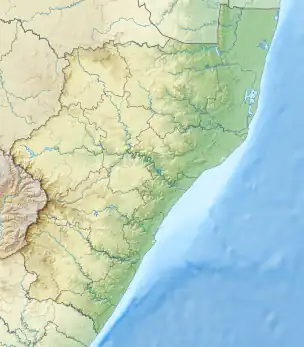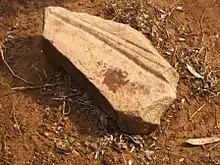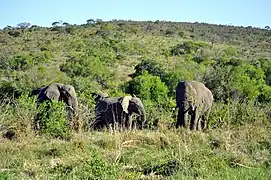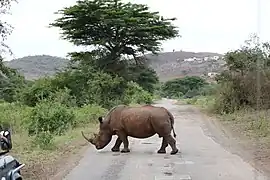| Hluhluwe–Imfolozi Park | |
|---|---|
.jpg.webp) | |
Hluhluwe–iMfolozi Park | |
| Location | KwaZulu-Natal, South Africa |
| Nearest city | Durban, South Africa |
| Coordinates | 28°13′11″S 31°57′7″E / 28.21972°S 31.95194°E |
| Area | 960 km2 (370 sq mi) |
| Established | 30 April 1895[1] |
| Governing body | Ezemvelo KZN Wildlife |
 Hluhluwe–Imfolozi Park (South Africa)  Hluhluwe–Imfolozi Park (KwaZulu-Natal) | |
Hluhluwe–Imfolozi Park, formerly Hluhluwe–Umfolozi Game Reserve, is the oldest proclaimed nature reserve in Africa. It consists of 960 km² (96,000 ha) of hilly topography 280 kilometres (170 mi) north of Durban in central KwaZulu-Natal, South Africa and is known for its rich wildlife and conservation efforts.[2] Operated by Ezemvelo KZN Wildlife, the park is the only state-run park in KwaZulu-Natal where each of the big five game animals can be found.[2]
Thanks to conservation efforts, the park now has one of the largest populations of white rhinoceros in the world,[3] although this population remains severely threatened by the poaching of hundreds of rhinos every year in the park.[4][5]
History

Throughout the park there are many signs of stone age settlements and iron smelting sites.[6] The area is claimed to have been declared a royal hunting ground for the Zulu kingdom in the time of Shaka.[6]
The southern white rhino, first identified by Western naturalist William John Burchell in 1812, was virtually eliminated during the 19th century by European hunters, and by 1895 was believed to be extinct. A population of between 20 and 100 was identified in South Africa and preserved by establishing the Umfolozi Junction Reserve and Hluhluwe Reserve, which are now parts of the Hluhluwe-Imfolozi Park.[7]
Historically, tsetse flies carrying the nagana disease protected the area from colonial hunters. Later, as the Zululand area was settled by white farmers, wildlife in the reserves was blamed for the prevalence of the tsetse fly, and the reserves became experimental areas in the efforts to eradicate the fly. Farmers called for the slaughter of game and over 100,000 animals were killed in the reserves between 1919 and 1950, although the rhino population was spared. The introduction of DDT spraying in 1945 virtually eliminated the tsetse fly from the reserves, although subsequent outbreaks have occurred.[8]
By the 1950s the white rhino population of the reserve had recovered to around 400, and the park's warden, Ian Player, established Operation Rhino in the 1950s and 60s, with the park's Rhino Capture Unit relocating hundreds of rhinos to establish populations in other reserves across their historic range.[7]
In 1989, the corridor between the Hluhluwe and Imfolozi reserves was added in order to join the separate reserves into the current single park.[6]
Geography and climate

The park is located in the province of KwaZulu-Natal on the east coast of South Africa. The park is closest to the town of Mtubatuba , Hluhluwe village and Hlabisa village. The geography of the area differs from the north, or Hluhluwe area, to the south, or Umfolozi area. Hluhluwe–Imfolozi Park is partly in a low-risk malaria area.[9]
Umfolozi
This area is situated between the two Umfolozi Rivers where they divide into the Mfolozi emnyama ('Black Umfolozi') to the north and the Mfolozi emhlophe ('White Umfolozi') to the south.[10] This area is to the south of the park and is generally hot in summer, and mild to cool in winter, although cold spells do occur.[2] The topography in the Umfolozi section ranges from the lowlands of the Umfolozi River beds to steep hilly country, which includes some wide and deep valleys. Habitats in this area are primarily grasslands, which extend into acacia savannah and woodlands.
Hluhluwe
The Hluhluwe region has hilly topography where altitudes range from 80 to 540 metres (260 to 1,770 ft) above sea level. The high ridges support coastal scarp forests in a well-watered region with valley bushveld at lower levels.[11] The north of the park is more rugged and mountainous with forests and grasslands and is known as the Hluhluwe area,[3] while the Umfolozi area is found to the south near the Black and White Umfolozi rivers where there is open savannah.[3]
Biodiversity

Fauna
The park is home to Africa's big five game: elephant, rhinoceros (black and white), Cape buffalo, lion and leopard. It is home to 86 special species[12] including: Nile crocodile, hippo, cheetah, spotted hyena, blue wildebeest, jackal, giraffe, zebra, waterbuck, nyala, eland, kudu, impala, duiker, suni, reedbuck, common warthog, bushpig, mongoose, baboons, monkeys, a variety of tortoises, terrapins, snakes and lizards.[2] It is one of the world's top spots for viewing nyala. The park is a prime birding destination and is home to 340 bird species.[12] The Hluhluwe River Flood Plain is one of the only areas in the whole of South Africa where yellow-throated, pink-throated and orange-throated longclaw species can be seen together.[2] Bird life include night heron, Wahlberg's eagle, Shelley's francolin, black-bellied korhaan, Temminck's courser, Klaas's cuckoo, little bee-eater and crested barbet.[10]
Flora
The park has a diverse floral community.[12]
Conservation efforts

Rhinoceros

The park is the birthplace of rhino preservation, having been responsible for breeding the southern white rhinoceros back from near extinction in the first half of the 20th century. There are reportedly 1,600 white rhino in the reserve.[3]
The rhino population remains severely threatened by poaching, with 222 rhinos poached in the province in 2017, most of them in the park.[4] Hluhluwe–Imfolozi has implemented Smart Park which facilitates the integration of systems, including drone technology, for early detection and rapid response of reaction units. On 6 March 2020 two of three suspected rhino poachers were killed in a shootout after they were detected by infrared cameras.[13] In 2022, 244 rhinos were poached in the province, 228 of them in the park.[5] In 2023, the reserve was the worst hit in South Africa; The Minister of Environment, Forestry and Fisheries, Barbara Creecy, said "We have to be concerned that almost every single day this year a rhino has been killed in Hluhluwe Imfolozi."[14]
African wild dog
In 1981, the Natal Parks board (now Ezemvelo KZN Wildlife) attempted to reintroduce African wild dogs into the park. Twenty-three dogs were released in the reserve, most of which had been bred in zoos. However this met with limited success and by 2015, the population had fluctuated between 3 and 30 individuals.[15] Further dogs were released into the park in 2022.[16]
Facilities
The first visitor camp was built at Hilltop in 1934, and is now the main camp in the northern (Hluhluwe) section of the park.[17] The main camp in the southern (Umfolozi) section is Mpila.[18] The reserve has a 300-kilometre (190 mi) road network.[12]
Impact of coal mining
The park ecosystems are threatened by the proximity of coal mines, with ongoing applications for prospecting and mine expansions on the western and southern edges of the park.[19]
Gallery
<
 Camp
Camp_-_52294296750.jpg.webp) Landscape
Landscape
_leaving_the_waterhole_..._(31511318983).jpg.webp) African Elephants at Mphafa Hide watering hole
African Elephants at Mphafa Hide watering hole_with_prey_..._(32226089805).jpg.webp)
 Herd of buffalo
Herd of buffalo
 White rhino crossing
White rhino crossing
See also
References
- ↑ Integrated Management Plan: Hluhluwe-Imfolozi Park, South Africa (PDF) (Report). Ezemvelo KZN Wildlife. 2011. p. 5. Archived from the original (PDF) on 16 December 2012. Retrieved 24 November 2012.
- 1 2 3 4 5 "Hluhluwe–Imfolozi Park". SA Places. Archived from the original on 17 July 2018. Retrieved 7 June 2008.
- 1 2 3 4 "Hluhluwe Umfolozi National Park". Game-Reserve.com. Retrieved 22 July 2022.
- 1 2 Carnie, Tony (5 April 2022). "Rhino bloodbath in KZN as poachers gun down 75 animals this year". Daily Maverick. Retrieved 11 July 2022.
- 1 2 "Rhino killings down 40% in Kruger, but Hluhluwe iMfolozi targeted by poachers". News24. 6 February 2023.
- 1 2 3 "Hluhluwe-iMfolozi Park (HiP)". Wildlife Act. Retrieved 11 July 2022.
- 1 2 "Facing Down a Crisis: How we Almost Lost the White Rhino". International Rhino Foundation. Retrieved 11 July 2022.
- ↑ Kappmeier, Karin; Nevill, E.M.; Bagnall, R.J. (1998). "Review of tsetse flies and trypanosomosis in South Africa" (PDF). Onderstepoort Journal of Veterinary Research. 65 (3): 195–203. PMID 9809324. Retrieved 11 July 2022.
- ↑ "Malaria risk map for South Africa". The South African National Travel Health Network (SaNTHNet). Archived from the original on 6 March 2014. Retrieved 20 October 2014.
- 1 2 "Hluhluwe–Umfolozi Game Reserve". Hluhluwe Accommodation. Archived from the original on 15 May 2008. Retrieved 7 June 2008.
- ↑ Cowgill, Roy; Davis, Steve; Forsythe, Erik (2001). "Hluhluwe-Umfolozi Park". Southern African Birding cc. Archived from the original on 24 May 2013. Retrieved 7 June 2008.
- 1 2 3 4 "KwaZulu-Natal Wildlife Special" (PDF). Baobab Travel. Archived from the original (PDF) on 9 May 2008. Retrieved 7 June 2008.
- ↑ Singh, Kaveel (15 March 2020). "Two suspected rhino poachers shot dead in KwaZulu-Natal game park". News24. Retrieved 11 July 2020.
- ↑ "Rhino poachers increasingly targeting private reserves, says minister". Business. Retrieved 24 September 2023.
- ↑ Ginsberg, Joshua; Cole, Mary (19 November 1994). "Wild at heart: The African wild dog, long persecuted as vermin, is down to a few thousand; is it too late for science to come to the rescue of this species?". New Scientist. Reed Business Information Ltd (1952): 34. Retrieved 9 August 2015.
- ↑ Whittington, Megan (19 May 2022). "African Wild Dog Conservation Efforts on Hluhluwe-iMfolozi Game Reserve". Wildlife ACT. Retrieved 11 July 2022.
- ↑ "Hilltop Resort". Ezemvelo KZN Wildlife. Retrieved 11 July 2022.
- ↑ "Mpila Resort". Ezemvelo KZN Wildlife. Retrieved 11 July 2022.
- ↑ Youens, Kirsten (30 June 2022). "Coal mining onslaught on Hluhluwe-iMfolozi Park is tantamount to ecocide". Daily Maverick. Retrieved 11 July 2022.
